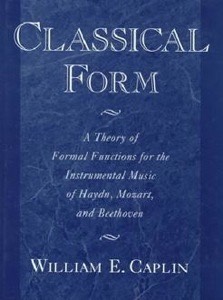A Theory of Formal Functions for the Instrumental Music of Haydn, Mozart, and Beethoven

Building on ideas first advanced by Arnold Schoenberg and later developed by Erwin Ratz, this book introduces a new theory of form for instrumental music in the classical style. The theory provides a broad set of principles and a comprehensive methodology for the analysis of classical form, from individual ideas, phrases, and themes to the large-scale organization of complete movements. It emphasizes the notion of formal function, that is, the specific role a given formal unit plays in the structural organization of a classical work.
Focusing on the music of Haydn, Mozart, and Beethoven, this book identifies numerous formal functions at multiple levels within a musical composition. All of these formal functions are thoroughly investigated and refined in order to determine their essential characteristics and how they interact with each other to create a variety of formal designs. Along the way, a host of concepts associated with harmony, tonality, and cadence are introduced and examined.
Classical Form features over 200 annotated musical examples drawn from a range of instrumental genres. These examples illustrate the theoretical principles presented in the book and serve as models for further analysis. Written for theorists, musicologists, and composers, the book is also useful for courses on formal and analysis and on the history of musical style.
Order Classical Form from Oxford University Press
"This ambitious book offers nothing less than a new theory of form for the music of the Classical period....In its combination of scholarship, musicality and sheer common sense, Caplin's Classical Form is a major achievement by any standards....it should be read by anybody who teaches, studies or writes about this music."—Music and Letters
"It is no exaggeration to say that [Classical Form] is one of the most important books on musical form to appear in the twentieth century....His book is an important and impressive statement that no theorist or musicologist can afford to ignore."—Music Theory Spectrum
"...a compilation of intriguing examples illustrating classical design and function, an up-to-date bibliographical guide, and a source of fresh insight into the accomplishments of the classical masters. Caplin's approach, buttressed by methodological rigor and theoretical detail, makes a persuasive case for the revival of Formenlehre as a pedagogical tool and analytical discipline."—Music Theory Online
Reviews of Classical Form
Azzaroni, Loris. Review of Classical Form. Il saggaitore musicale: Rivista semestrale di musicologica 8/2 (2001): 325
Galand, Joel, “Formenlehre Revisited: Review-Essay on William Caplin's Classical Form,” Intégral 13 (2001): 143–200.
Marston, Nicholas, “Review of Classical Form,” Music Analysis 20/1 (March 2001): 143–49.
Bergé, Pieter, “In de sporen van Schönberg: Caplins theorie van de “Classical Form,” Tijdschrift voor Muziektheorie 5/3 (November 2000): 204–210.
Check, John, “Review of Classical Form,” Notes (September 2000): 101–103.
Darcy, Warren. “Review of Classical Form,” Music Theory Spectrum 22/1 (Spring 2000): 122–25.
Spitzer, Michael, “Review of Classical Form,” Music and Letters 81/1 (February 2000), 110–15.
Bey, Henning. “Review of Classical Form,” Mozart-Jahrbuch 1999, 117-119.
de Médicis, François, “Review of Classical Form,” Revue de musique des universités canadiennes 20/1 (1999): 107–13.
Grave, Floyd, "Review of Classical Form," Music Theory Online 4/6 (1999).
Neff, Severine, “Review of Classical Form,” Indiana Theory Review 20/2 (1999): 41–55.
Stroh, Patricia Elliott. “Review of Classical Form,” The Beethoven Journal 13/1 (1998): 39.